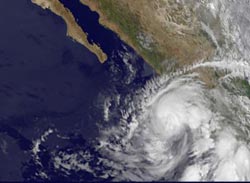NASA sees Hurricane Beatriz 'wink' on the Mexican coast

The GOES-11 satellite captured this image at 1230 UTC (8:30 a.m. EDT/5:30 a.m. PDT) that shows Hurricane Beatriz on the coast of southwestern Mexico. Note that Beatriz' eye is not visible. Credit: NASA/NOAA GOES Project<br>
Last night (June 20, 2011) by 8 p.m. EDT, heavy rains were spreading over the southwestern Mexican coast. At that time, Beatriz was still a tropical storm. By 11 p.m. EDT Beatriz had strengthened into a hurricane. At 5 a.m. EDT today, June 21, Beatriz' center was only 15 miles from Manzanillo and that means the city was experiencing hurricane-force winds and heavy rainfall because hurricane force winds extended 25 miles from the storm's center.
Manzanillo is a city and a surrounding municipality in the Mexican state of Colima. The city is known for tourism, deep-sea fishing, is a port of call for cruise lines and is Mexico's busiest cargo port.
On June 20 at 17:40 UTC (1:40 p.m. EDT) the Moderate Resolution Imaging Spectroradiometer known more commonly as “MODIS” that flies on NASA's Terra satellite captured a visible image of Hurricane Beatriz off the coast of western Mexico. Beatriz was a tropical storm at that time and an eye had not yet materialized.
More than 12 hours later, microwave imagery from the Atmospheric Infrared Sounder instrument on NASA's Aqua satellite revealed an eye in the storm for a short time. The eye “opened” and appeared well defined and between 20 and 20 nautical miles wide. AIRS also detected that the cloud top temperatures in the thunderstorms surrounding the eyewall were colder than -80 Fahrenheit!
Later this morning, that eye appeared to have “closed” on satellite imagery from the Geostationary Operational Environmental Satellite called GOES-11. GOES-11 is managed by NOAA, while the NASA GOES Project at the NASA Goddard Space Flight Center in Greenbelt, Md. creates images and animations from the satellite, including today's image. The GOES-11 satellite showed Hurricane Beatriz at 1230 UTC (8:30 a.m. EDT/5:30 a.m. PDT) was on top of the coast of southwestern Mexico. Beatriz's eye was not visible in this morning's image.
At 8 a.m. EDT (5 a.m. PDT), Hurricane Beatriz had maximum sustained winds near 90 mph (150 kmh) with higher gusts. It was moving northwest near 13 mph (20 kmh). Minimum central pressure is 997 millibars. Beatriz was on the coast and its center was about 15 miles (20 km) south-southeast of La Fortuna near 19.4 North and 105.0 West. It's now 50 miles west-northwest of Manzanillo, Mexico and moving away after drenching the city earlier today.
Currently a hurricane warning is in effect for the coast of Mexico from Lazaro Cardenas northwestward to Cabo Corrientes.
The National Hurricane Center noted that there's a chance that Beatriz may strengthen a little more this morning, and once the center of the hurricane interacts with the land of the coast it will begin weakening. In addition, Beatriz continues to move northward into cooler sea surface temperatures, which will also zap its strength.
NASA's Hurricane page; www.nasa.gov/hurricane
Media Contact
All latest news from the category: Earth Sciences
Earth Sciences (also referred to as Geosciences), which deals with basic issues surrounding our planet, plays a vital role in the area of energy and raw materials supply.
Earth Sciences comprises subjects such as geology, geography, geological informatics, paleontology, mineralogy, petrography, crystallography, geophysics, geodesy, glaciology, cartography, photogrammetry, meteorology and seismology, early-warning systems, earthquake research and polar research.
Newest articles

Bringing bio-inspired robots to life
Nebraska researcher Eric Markvicka gets NSF CAREER Award to pursue manufacture of novel materials for soft robotics and stretchable electronics. Engineers are increasingly eager to develop robots that mimic the…

Bella moths use poison to attract mates
Scientists are closer to finding out how. Pyrrolizidine alkaloids are as bitter and toxic as they are hard to pronounce. They’re produced by several different types of plants and are…

AI tool creates ‘synthetic’ images of cells
…for enhanced microscopy analysis. Observing individual cells through microscopes can reveal a range of important cell biological phenomena that frequently play a role in human diseases, but the process of…





















